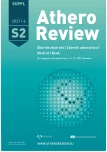19ÚS Soluble endoglin: Anything new and interesting?
19ÚS Soluble endoglin: Anything new and interesting?
Introduction: Endoglin is a 180 kDa transmembrane glycoprotein that was demonstrated to be present in two different forms, namely membrane endoglin (Eng) and soluble endoglin (sEng). Increased sEng levels in the circulation have been detected in atherosclerosis, arterial hypertension, and type II diabetes mellitus. sEng is now considered an important biomarker of cardiometabolic disorders. We aimed to evaluate the potentially harmful effects of high sEng levels in combination with other risk factors of cardiometabolic disorders. Results: We demonstrated the harmful effects of sEng with respect to the development of endothelial dysfunction and liver disorders. Long-term hypercholesterolemia combined with high levels of sEng resulted in the aggravation of endothelial and vessel wall dysfunction in the aorta, with possible alterations of the membrane endoglin/eNOS. In addition, long-term exposure to high levels of sEng during aging results in alteration of vasoconstriction properties of the aorta, reduced eNOS phosphorylation, decreased Eng expression, and altered Eng signaling. sEng also activates the expression of BM4, resulting in the development of arterial hypertension. Moreover, high levels of human sEng result in increased hepatic deposition of cholesterol due to reduced conversion into BA, as well as redirects the metabolism of triglycerides (TAG) to its accumulation in the liver via reduced TAG elimination by -oxidation combined with reduced hepatic efflux. Finally, sEng was shown to be reduced after Lipoprotein apheresis (after each procedure and in long term perspective) in patients with Familial hypercholesterolemia. Conclusion: In conclusion, we propose that sEng can be considered a risk factor for the development of vascular dysfunction and liver alteration, suggesting it might be the potential therapeutical target for pharmacological intervention in these cardiometabolic disorders.
Autoři:
Nachtigal P 1; Igreja E Sá Ic 1; Tripska K 1; Vitverová B 1; Najmanová I 1; Eissazadeh S 1; Víšek J 2; Bláha M 3; Blaha V 2; Micuda S 4
Působiště autorů:
Department of Biological and Medical Scviences, Faculty of Pharmacy, Charles University, in Hradec Králové, Czech Republic
1; Department of Pharmacology, Faculty of Medicine Charles University, Hradec Králové, Czech Republic
4; rd Department of Internal Medicine, Metabolizm and Gerontology Faculty of Medicine, Charles University and, University Hospital Hradec Králové, Czech Republic
23; th Department of Internal Medicine-Hematology, Faculty of Medicine Charles University and University Hospital, Hradec Králové, Czech Republic
34
Vyšlo v časopise:
AtheroRev 2021; 6(Supplementum 2): 16
Kategorie:
Varia
Souhrn
Introduction: Endoglin is a 180 kDa transmembrane glycoprotein that was demonstrated to be present in two different forms, namely membrane endoglin (Eng) and soluble endoglin (sEng). Increased sEng levels in the circulation have been detected in atherosclerosis, arterial hypertension, and type II diabetes mellitus. sEng is now considered an important biomarker of cardiometabolic disorders. We aimed to evaluate the potentially harmful effects of high sEng levels in combination with other risk factors of cardiometabolic disorders. Results: We demonstrated the harmful effects of sEng with respect to the development of endothelial dysfunction and liver disorders. Long-term hypercholesterolemia combined with high levels of sEng resulted in the aggravation of endothelial and vessel wall dysfunction in the aorta, with possible alterations of the membrane endoglin/eNOS. In addition, long-term exposure to high levels of sEng during aging results in alteration of vasoconstriction properties of the aorta, reduced eNOS phosphorylation, decreased Eng expression, and altered Eng signaling. sEng also activates the expression of BM4, resulting in the development of arterial hypertension. Moreover, high levels of human sEng result in increased hepatic deposition of cholesterol due to reduced conversion into BA, as well as redirects the metabolism of triglycerides (TAG) to its accumulation in the liver via reduced TAG elimination by -oxidation combined with reduced hepatic efflux. Finally, sEng was shown to be reduced after Lipoprotein apheresis (after each procedure and in long term perspective) in patients with Familial hypercholesterolemia. Conclusion: In conclusion, we propose that sEng can be considered a risk factor for the development of vascular dysfunction and liver alteration, suggesting it might be the potential therapeutical target for pharmacological intervention in these cardiometabolic disorders.
Štítky
Angiologie Diabetologie Interní lékařství Kardiologie Praktické lékařství pro dospěléČlánek vyšel v časopise
Athero Review

2021 Číslo Supplementum 2
- Isoprinosin je bezpečný a účinný v léčbě pacientů s akutní respirační virovou infekcí
- Metamizol jako analgetikum první volby: kdy, pro koho, jak a proč?
- Není statin jako statin aneb praktický přehled rozdílů jednotlivých molekul
Nejčtenější v tomto čísle
- 08ÚS Multifaktoriální chylomikronemie
- 09ÚS Post mortem vyšetření náhlé srdeční smrti: výstupy
- 26PS Využití chytrých hodinek ke kardiorehabilitaci pacientů po infarktu myokardu: pilotní výsledky studie SmartRehab.
- 01ÚS Labetalol treatment exacerbates estrogen-induced liver damage
